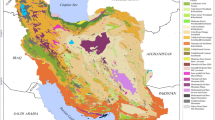Abstract
Results of classification of terrestrial ecosystems using an average similarity matrix are reported for the West Siberian Plain. Initial indices are first calculated separately for four components of an ecosystem. These components (blocks) include the underground block (soil humus, mortmass, and underground phytomass), above-ground vegetation, and invertebrates and vertebrates. Mismatch of boundaries in separate blocks of ecosystems and in comparison with the inhomogeneity of ecosystems in general was demonstrated. These differences are observed in both the typological and typological-chorological analysis. The indicated features of spatial succession within the blocks generate continuity of ecosystems and the conventional character of all the classifications and drawn boundaries.
Similar content being viewed by others
References
V. P. Sedel’nikov, Yu. S. Ravkin, A. A. Titlyanova, I. N. Bogomolova, and O. N. Nikolaeva, “Spatial-Typological Differentiation of Ecosystems of the West Siberian Plain. Communication I. Plant Cover,” Sibirskii Ekologicheskii Zh. 18(3), 311 (2011) [Contemporary Problems of Ecology 4 (3), 229 (2011)].
V. A. Khmelev, A. A. Titlyanova, V. P. Sedel’nikov, Yu. S. Ravkin, I. N. Bogomolova, and I. P. Kokorina, “Spatial-Typological Differentiation of the Ecosystems of the West Siberian Plain. Communication II: Underground Phytomass, Dead Organic Matter, and Soil Humus,” Sibirskii Ekologicheskii Zh. 18(3), 325 (2011) [Contemporary Problems of Ecology 4 (3), 241 (2011)].
M. G. Sergeev, B. R. Striganova, V. G. Mordkovich, V. V. Molodtsov, O. N. Nikolaeva, and I. N. Bogomolova, “Spatial-Typological Differentiation of Ecosystems of the West Siberian Plain. Communication III: Terrestrial Invertebrates,” Sibirskii Ekologicheskii Zh 18(4), 467 (2011) [Contemporary Problems of Ecology 4 (4), 347 (2011)].
Yu. S. Ravkin, I. N. Bogomolova, and S. V. Chesnokova, “Spatial-Typological Differentiation of Ecosystems of the West Siberian Plain. Communication IV: Terrestrial Vertebrates,” Sibirskii Ekologicheskii Zh. 18(4), 475 (2011) [Contemporary Problems of Ecology 4 (4), 355 (2011)].
I. S. Il’ina, E. I. Lapshina, N. N. Lavrenko, L. I. Mel’tzer, E. A. Romanova, B. A. Bogoyavlenskii, and V. D. Makhno, Vegetation of theWest Siberian Plain. A Map of scale 1: 1 500 000 (GUGK, Moscow, 1976) [in Russian].
Soviet Encyclopedic Dictionary (Sov. Entsiklopediya, Moscow, 1987) [in Russian].
V. A. Yudkin, Ecological Aspects of Avian Geography in Northern Eurasia (Nauka, Siberian Branch, Novosibirsk, 2009) [in Russian].
Yu. S. Ravkin, I. N. Bogomolova, and N. S. Moskvitina, “Classification Differences of Small Mammal Communities inWest Siberia,” Vestnik Tomsk Univ., Biologiya, No. 1 (9), 42 (2010).
Author information
Authors and Affiliations
Corresponding author
Additional information
Original Russian Text © Yu.S. Ravkin, V.P. Sedel’nikov, M.G. Sergeev, A.A. Titlyanova, V.A. Khmelev, I.N. Bogomolova, S.M. Tsybulin, 2011, published in Sibirskii Ekologicheskii Zhurnal, 2011, Vol. 18, No. 6, pp. 773–788.
Rights and permissions
About this article
Cite this article
Ravkin, Y.S., Sedel’nikov, V.P., Sergeev, M.G. et al. Spatial-typological differentiation of ecosystems of the West Siberian Plain. Communication V: Terrestrial ecosystems. Contemp. Probl. Ecol. 4, 568–581 (2011). https://doi.org/10.1134/S1995425511060026
Published:
Issue Date:
DOI: https://doi.org/10.1134/S1995425511060026




